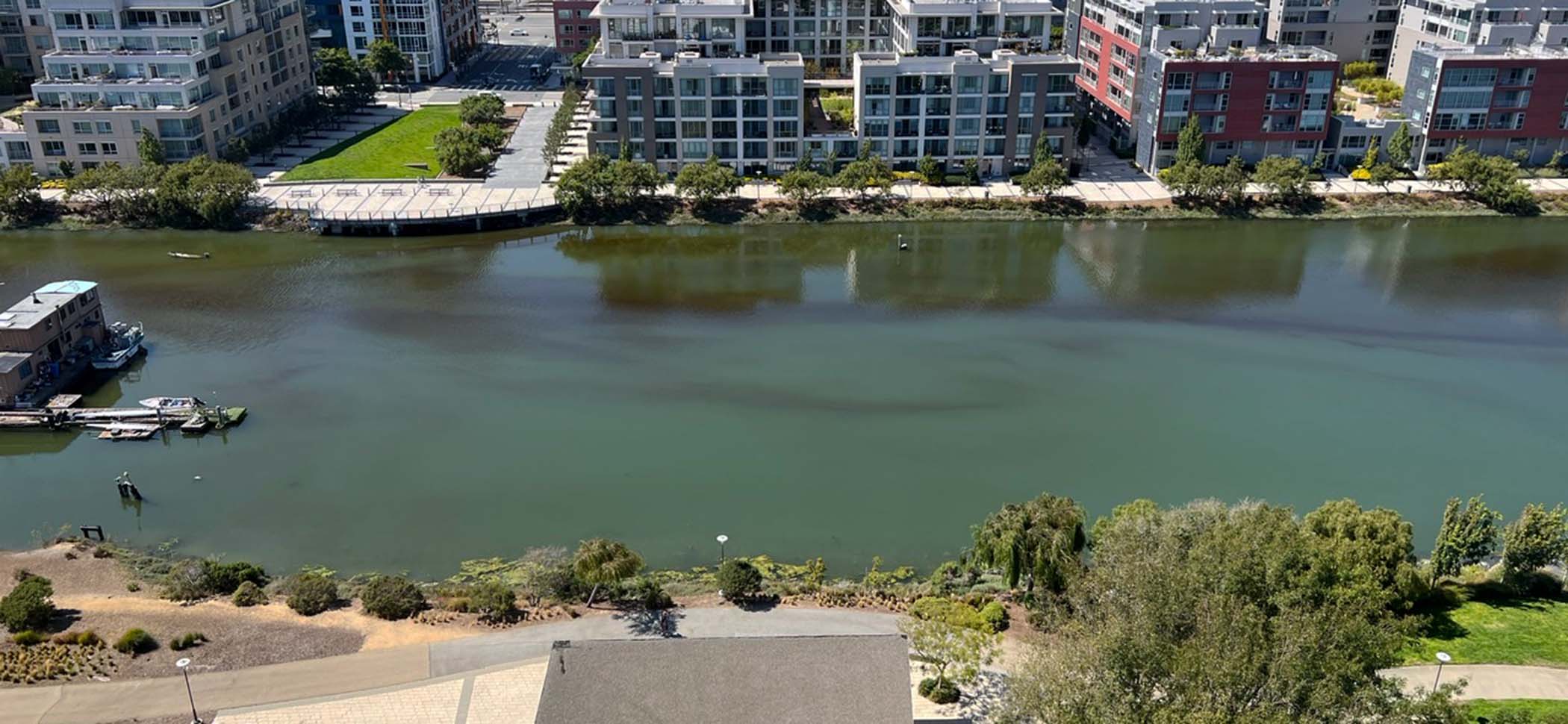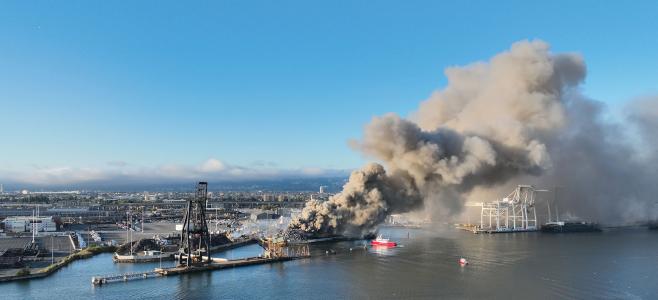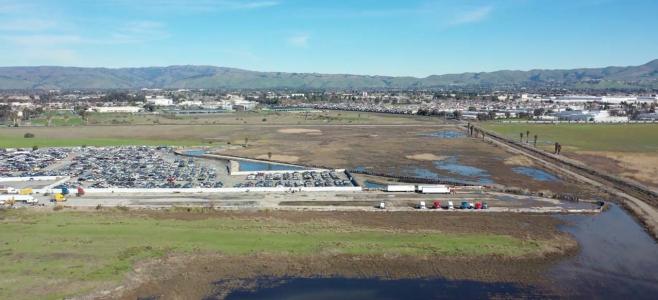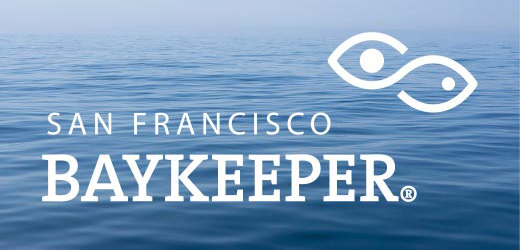San Francisco Bay and the Delta are home to countless microorganisms that are invisible to the naked eye. At normal levels, microorganisms like algae and bacteria are the basis of a thriving food web. But when conditions are ripe, certain kinds of algae and bacteria can grow out of control, causing a visible “bloom.” Large scale blooms don’t happen often in the Bay, but when they do, they can wreak havoc on the ecosystem and pose a danger to wildlife and people.
In the summer of 2022, the Bay experienced a harmful algae bloom (HAB) of Heterosigma akashiwo, which turned the Bay a reddish-brown color. This harmful bloom caused catastrophic die-offs of fish and other aquatic life to the point where scientists are now concerned about the survival of the Bay’s remaining white sturgeon population. And in recent years, the Delta has experienced neon-green blooms of toxic cyanobacteria—sometimes referred to as blue-green algae. These blooms are known to be harmful to people and pets.

Pictured: A harmful algae bloom in Mission Creek in San Francisco in 2022. Photo: Benjamin Feingold
What causes harmful blooms?
Algae and cyanobacteria need light, temperature, and nutrients (phosphorous and nitrogen) to grow and reproduce. Blooms typically form when the weather is warm and sunny, the water contains excessive levels of phosphorus and nitrogen, and the water is slow moving. Faster flowing water can inhibit the formation of a bloom by dispersing cells and reducing the growth rate.
In the Delta, a significant source of nutrient pollution includes agricultural runoff from Central Valley agribusiness. The major sewage treatment facilities near the Delta have undergone costly upgrades to reduce the amount of nutrients they contribute to the problem. Yet, blooms still occur there during the late-spring and summer because weak river flows concentrate the pollution and encourage blooms.
San Francisco Bay has some of the highest levels of nutrient pollutants of any estuary in the world, making it highly susceptible to blooms of all kinds.
In the Bay, sewage treatment plants are the main sources of nitrogen and phosphorous and result in about 65 percent of the pollution problem. Other nutrient inputs to the Bay include runoff from city streets, agricultural discharges, and waste from significant industrial operations, such as local oil refineries. However, treated municipal wastewater is by far the largest source of nutrients in the Bay, particularly during the dry season when blooms are most likely to form. Of the 37 wastewater treatment plants that surround the Bay, the East Bay Municipal Utilities District and the San Francisco Public Utilities Commission are currently the biggest contributors.

Drone shot of a harmful algae bloom in Stockton in 2021. Photo: Baykeeper
What makes a bloom harmful?
Most algae and bacteria are not harmful, and usually species that can develop into harmful blooms are not problematic at low levels.
Some of these microorganisms produce toxins that can cause health problems in people and wildlife. These toxins can also build up in shellfish, poisoning people who eat them. For example, domoic acid, a potentially fatal toxin produced by the algae Pseudo-nitzschia, sometimes reaches dangerous levels in Dungeness crabs, causing health-related fishery closures along the coast.
Cyanobacteria blooms, like the ones found in the Delta (pictured, above), produce a range of toxins with acute health effects in people, including gastrointestinal and neurological symptoms. These toxins can even travel short distances through the air and be inhaled, leading to respiratory problems.
But toxins are not the only reason a bloom may be harmful. Algae blooms sometimes deplete dissolved oxygen levels in the water and, as a result, can suffocate other aquatic life.
What are the solutions?
In the Bay, the key to preventing future algae blooms is to reduce nutrient pollution from the region’s wastewater treatment facilities. This will require major overhauls to infrastructure, and natural solutions like wetlands restoration.
The upside is that these investments can yield multiple benefits if designed carefully. Recycling water removes nitrogen and phosphorus while reducing our reliance on California’s over-tapped rivers. Wetlands can protect Bay Area communities from flooding and absorb excess nitrogen and phosphorus in the Bay’s waters.
Take Action: Tell Local Agencies to Reduce sewage & Refinery Pollution in the Bay
In the Delta, preventing or limiting future toxic blooms will require restoring river flows in the San Joaquin and Sacramento rivers. A flowing river disperses cyanobacteria before a bloom can form —but at times, up to 90 percent of the San Joaquin River’s flow is diverted to industrial agricultural operations and big cities.
To prevent harmful blooms throughout the Bay’s watershed, Baykeeper advocates for stronger regulations to reduce sewage and refinery pollution; we urge agencies to adopt nature-based and multi-benefit solutions; and we stand up for increased river flows coming into the Delta.
If you see discolored water or other signs of a suspected bloom, reach out to our patrol team here by clicking here or call 1-800-KEEP-BAY


